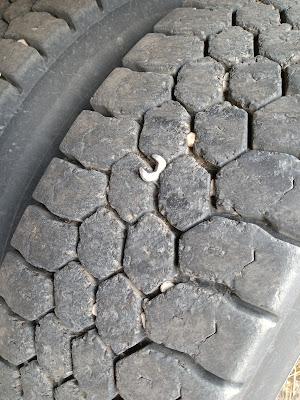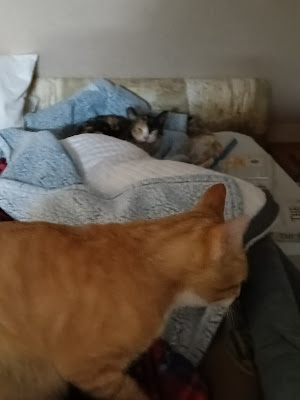Back at The Farm, one of my “happy places” with Farmer Bob, Dylan, Chris, Holly and DeAnne. For those of you who have been reading the blog for a few years, it may seem like Groundhogs Day as many of the tasks are ones I have done in previous years. The biggest difference this year is that I am alone. Barb stayed home with both the girls, so it is just me and the camper. Harvest has been under way for over a month. All the wheat, peas and canola fields are already harvested. The only crop left to bring in is the soybeans and they are not quite ready yet, needing another week or so before they are ready to harvest.
There is always something new when I return. New equipment,
new fields to work, but this year when I drove into the farmyard the biggest
difference was not what was new, but what was missing. The old farmhouse where
Farmer Bob grew up, where his dad grew up and where his grandparents lived is
gone. Nothing left but bare dirt where the house once stood. One cannot help
but get a little melancholy thinking about all the history in that house, but it
was time. Something new will take its place at some point and new history will
begin.
The new thing I noticed was a new Quadtrac! A new toy for me
to play with! This one is a 550, which I will be using for carting and other
field work.
While we wait for the soybeans, there is plenty of other work to do. My first day here I spent the entire day in the semi, hauling wheat to the elevator. To do this you have to get the grain out of the bin via a conveyer (oh, that is new too) and into the semi.
These bins are huge with an approximate capacity of 3,000,000 pounds of wheat! I don't mind most everything I do up here but there is one sucky job. Once the bin gets low you have to go into it, turn on the rotating auger and shovel/sweep out the remaining grain. The grain dust in the air is horrible! Even this job is not that sucky if you wear a mask, but I was in a hurry and just jumped in without one. I paid for that the next couple of days! Needless to say, I got a mask the next time I went in.
At the elevator they are constructing several more concrete silos. The thing I noted about these was the stairs going up the outside as I watched the workers start from the bottom and climb their way up to the top. Those guys must have calves of steel! If you look closely, you can see a couple of guys near the bottom working their way up.
Once at the elevator you scan in so they know what farm you are from, then they take a test sample of the grain and analyze it before you move on. Then you proceed to the scale (straight ahead of me in the picture above) and get your loaded weight. Then you move ahead and dump your load through a drive-over grate.
All was going well until I was at the elevator and noticed this....
Well, that just threw a wrench into my plans (see what I did right there?) I limped the truck back to the farm, Chris took the tire off and a sent it to town for repair. Once it came back, I put it back on and it was as good as new!
It must have been tire day as Chris and I switched out the tires on the sprayer. Man, these things are huge!
The next day was wet and cool so we spent the day indoors working on getting the combines ready for the soybeans. There is a lot of wear and tear on these things in the fall so I spent an afternoon replacing sections on the sickle. I don't know how many sections are on one of these but there is a lot!
Some of the crops are more forgiving and can be harvested with a broken section blade. Soybeans is not one of them. If you ever go down the road and see one row left in a harvested field rest assured that they had a broken section. I replaced close to two dozen sections so now the combines are ready to go!
I had a little extra time so I decided to tackle an issue with the camper that has been plaguing us since this summer. Barb had noticed a slow water leak from under the camper so I slide it partially off the truck to see if I could find out where it was coming from. I traced it back to the area under the toilet. The problem was that there was no way to get to it as everything was riveted tight. I could see the water dripping out and could even hear a hiss of a leak but I could not get to it. Finally I drilled out the rivets holding the outdoor shower valves and discovered the problem.
My next task was clearing tree rows. Most of the tree rows you see in farm fields were planted years ago to prevent erosion of the soil from the wind. They are a blessing and a burden as they are always in the way and once they mature the branches grow into the fields interfering with the planting and harvesting. So, I set about limbing them up.
The field I was
working on has 4 tree rows totaling about 2 miles long. I thought, no problem I
will get one (~1/2 mile) done each day. 6 hours later I was not even ¼ of the
way through the first tree row. It is hard, back breaking work as you are
operating a chainsaw or pole saw over your head for hours each day. Then you
have to drag each limb out in the field and pile it up so you can pick it up
with the loader tractor later. As of right now I have about 15 hours into this
one d@#m row, and I still have several hundred yards left!
Then I went and got the loader tractor with grapple arms and moved all the piles to the field edge where they will serve as shelter for the bunnies and pheasants.
That night I returned to my camper tired and exhausted. I climbed into the camper to find this in my bed....
Two of the cats were all snuggled into my blankets and looked at me like I was interrupting the most peaceful sleep they have ever had! The orange cat made a quick exit but the other one I had to go up grab and drag out as her claws tried as hard as they could to stay right where she was.
On day 5 of my visit the fields were dry enough to get out
and do a little field work. Not harvesting but harrowing. Picture if you will a
spiked drag that many of us use to level our gardens, yards or driveways. Now,
increase the size of said drag to 72’ with hundreds of spikes. That is what
this harrow looks like.
The purpose of harrowing is to lift the residue from the
previous crop that has already been harvested. In this case I was doing wheat
fields harrowing 600 or so acres over a 2-day period. Back and forth in the
field at 8.5mph. It works best with a little wind so it blows much of the
residue away when it is lifted making it much easier for planting next year.





























































